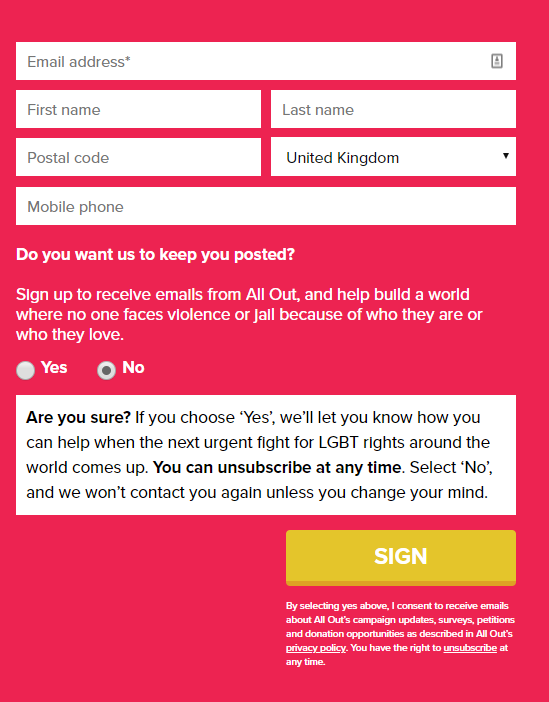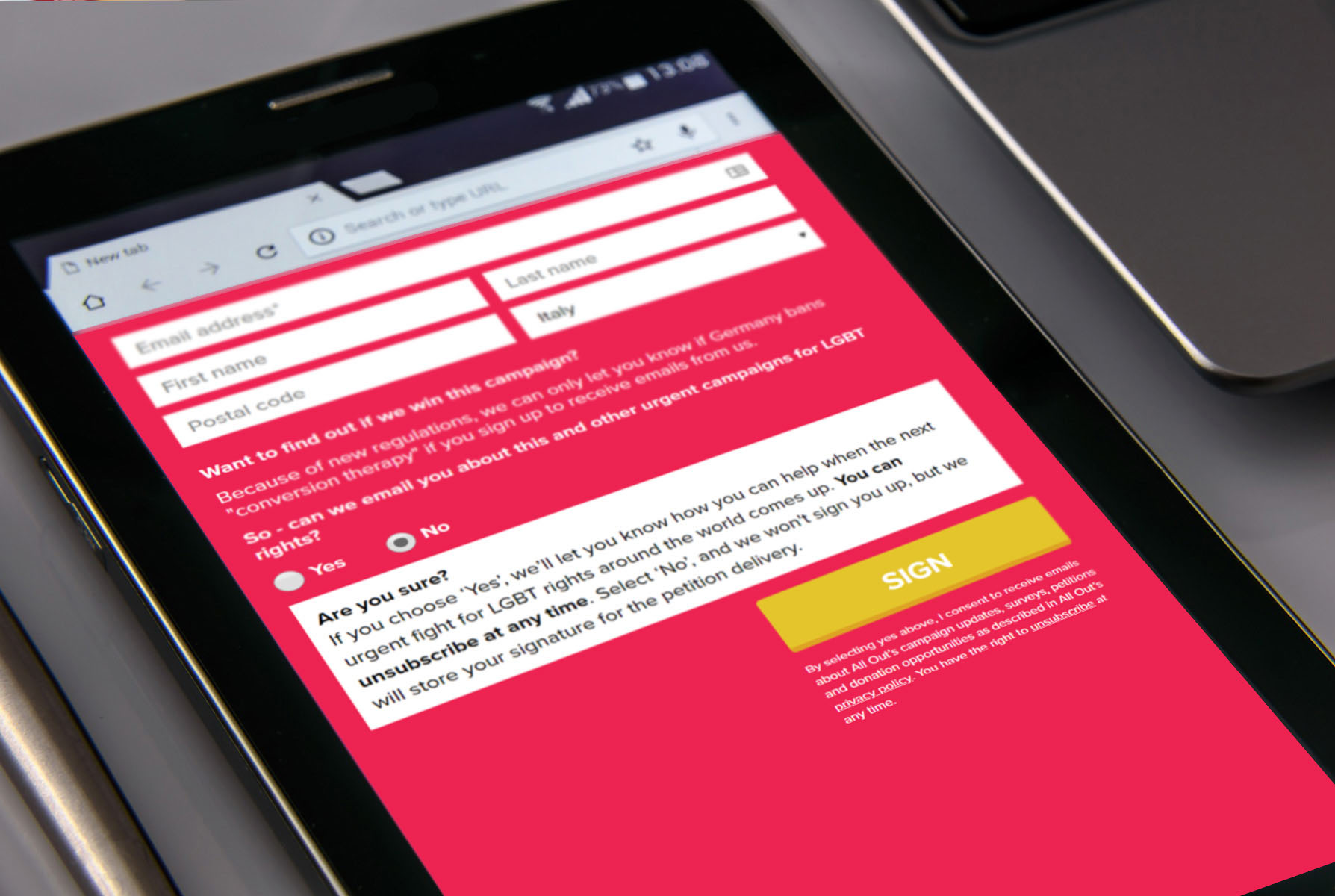When the new General Data Protection Regulation (GDPR) comes into force in May, organisations won’t be able to assume consent to email supporters any more. Instead, supporters will have to actively opt in to receive emails when they sign up — and to do that effectively, we a) need to give supporters a compelling reason to subscribe and b) make it easy for them to do so.
To help organisations prepare for this new world, we’ve been running optimisation testing of opt in formats with a number of organisations, including the global LGBT movement, All Out.
We recently ran a opt in copy test with All Out that produced particularly high opt in rates — as much as 77% on one test — and produced learnings that we think have relevance for a lot of other organisations. We’ve written this up below in the hope that it might help other charities with their own opt in testing programmes.
What we tested
We tested two different versions of opt in copy on a petition page for All Out. Our aim was to see if using the copy to emphasise different incentives to sign up for emails could increase opt in rates.
The Control
The opt in format most commonly-used by charities is a simple un-ticked checkbox:

Our previous tests — alongside a growing body of those run by other organisations who’ve found the same result — have shown that a checkbox tends to generate very low opt in rates; typically just 10–15%. Instead, we’ve found that giving a user an opt in ask with a set of two radio buttons (Yes and No, neither of which is selected when the user lands on the page) can as much as double opt in rate. This is largely because — unlike the checkbox — it forces the user to make an active choice whether to opt in or not.
We used this radio button structure as control for the test. Neither radio button was selected when the page loaded. If the user selected no, they were shown a message asking them to reconsider (a tactic that has also proved effective in testing):

The language used for the main opt in ask focuses on incentivising supporters to opt in with theory of change — offering the user a way to help build a better world if they sign up for email.
The Test Variant
Against this broader theory-of-change ask, we tested a framing that more heavily focussed on the campaign the user had just signed up for. Our hypothesis was that supporters would want to hear if the campaign was successful, so used the opt in language to point out we’d be unable to contact them about the campaign win if they didn’t opt in:

What we found out
We tested this approach on two petitions (adapting the copy appropriately for each petition).
The results were striking. On the first petition, the “campaign win” framing produced a relative increase of 48% (statistically significant). Opt in rate rose from 52% on the “theory of change” control to 77%, the highest opt in rate we’ve seen on a petition to date in our testing.
Opt in rates were lower overall on the second petition, but the “campaign win” variant still increased opt in rate by 32% (statistically significant) from 38% up to 50%.

It’s also interesting to note that this test reflects a trend we’ve seen with other petitions: opt in rate varies substantially between different petitions run by the same organisation. The pattern (perhaps unsurprisingly) seems to be this: the more compelling users find the topic of a petition, the higher the opt in rate. Isolating this to Facebook ads, for example, we’ve seen the lower the cost-per-signature of ads promoting a petition, the higher the opt in rate — I.e. not only are you getting more signers, but each of those is also more like to opt in.
What this means for your organisation
If there’s one thing to take away from this test, it’s this: all opt in language is not equal.
Too often, we come across opt in language clearly dictated by legal teams and focused only on remaining GDPR compliant. It’s too long, too complex or too dry, and often all three.
Legal compliance is, of course, one half of the role opt in language has to fulfill — but it also has to actually get supporters to subscribe, and charities and campaigns groups cannot afford to ignore this second role. Email list growth is essential to the success of digital programmes: it is the foundation upon which your digital fundraising and ability to mobilise to win campaigns is built. The tens of thousands of extra All Out supporters this new opt in format will create will not only increase All Out’s ability to fundraise online to support their mission, they will enable them to mobilise more people and — ultimately — win more campaigns.
If you’re not already testing your opt in language, we’d suggest starting with this question: what are all the different motivations people might have to subscribe to our email list? e.g. Wanting to have impact; being part of a movement; wanting updates on a specific campaign etc. All the opt in language you test should speak to at least one of those motivations: providing a clear and powerful incentive to sign up is core to any successful opt in ask.
What we’re testing now
The next steps for our testing is to refine the messaging of the opt in, both in the ask above the radio buttons and the message that appears if they select “no”. We’ll build on the result from this and other tests we’re doing across the progressive space.
If you have any thoughts on this experiment, any examples of GDPR experiments you’ve run, or any ideas for future GDPR testing, put them in the comments or drop us an email — we’d love to hear from you!

